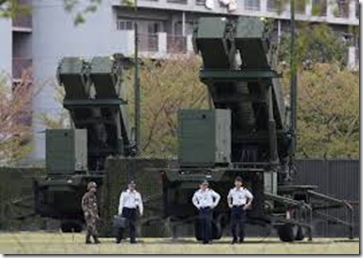A few days ago, I predicted there would be no war, probably because I’m lazy and predicting the future will be the same as the present is an easy way to protect my credibility. But I got some criticism that I was a dippy academic who doesn’t see how dangerous the situation really is. And if I am wrong, I won’t be around to see it anyway; I’ll be swimming for Japan. So here is the most likely escalation pathway I can see, despite my firm conviction the North Koreans do not want a war, because they will lose badly and quickly, and then face the hangman in Southern prisons.
I noted that NK could get entrapped by its own belligerent rhetoric and be forced to escalate even if it doesn’t want to. I think this is why Kaesong was closed, for example. I also noted how sanguine South Koreans are about NK, but foolishly, I didn’t really think about the Japanese. Then came the story about a mistweet by the city of Yokohama that apparently created local panic.The Japanese seem far more nervous about this than South Koreans, and NK did launch a missile once over Japan. The Japanese have also been talking a lot tougher, and Abe is clearly a hawk on NK.
So here we go:
1. April 15 is the birthday of the Great Korean Leader (wae-dae-han chosun suryong) Kim Il Sung. It is well-known that the Norks like holidays and anniversaries and commemorate them with their international hijinks. And no holiday is bigger than KIS’ birthday, around whom the whole state is built. His birthday is even the point of origin of an internal North Korean calendar.
2. The missiles most US and SK intelligence expect to be launched are on the east coast, on the Sea of Japan.
3. Unstated Japanese policy I’ve been told is not to shoot down NK missiles, even in overflight, unless the trajectory would actually bring a missile down on Japanese territory. Less clear is what they would do it were expected to land in Japanese waters.
3. So on April 15, or shortly thereafter, NK tests one or more missiles over the Sea of Japan. NK telemetry is poor – the improvement of which is the technical purpose behind all these missile launches.
4. One of the missiles strays to close to Japan, and they shoot it down.
5. What does the North Korean military do next? Recall that ‘military first’ (son-gun) has been the dominant ideology for 15 years, and the whole purpose of NK now, after the end of the Cold War and bankruptcy of communism, is to defend against ‘imperialism,’ of which the Japanese are a potent symbol due to their colonial venture in Korea from 1910-45. So post-shoot-down, there could be huge pressure on the military to do something to legitimize its continuing privileged position, particularly before the other parts of the regime whom the military’s gargantuan defense spending (25-35% of GDP) is starving.
6. Because Japan is far away, North Korea does something dangerous where it normally does – in the Yellow Sea with SK. SK President Park, who’s said a counter-strike will occur on the next provocation ‘without any political consideration,’ follows through and allows the SK navy or air force to attack a NK port or something. Given how important this is, here are her words in the original: “만약 우리 국민과 대한민국에 대해 어떤 도발이 발생한다면 일체 다른 정치적 고려를 하지 말고 초전에 강력 대응해야 할 것.”
7. This then sets off a tit-for-tat North/South escalation that no one really knows where or how would stop.
Despite being the most likely possible path to a conflict, I still don’t think it is in fact likely. Step 4 is really doubtful unless the missile is coming right down on a Japanese city, because lots of other people in Japan and US Forces in Japan have probably thought about this problem too, and, in step 7, I don’t think President Park is too reckless.
Cross-posted at Asian Security Blog.
Associate Professor of International Relations in the Department of Political Science and Diplomacy, Pusan National University, Korea
Home Website: https://AsianSecurityBlog.wordpress.com/
Twitter: @Robert_E_Kelly


0 Comments